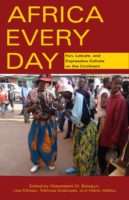The book Africa Every Day: Fun, Leisure, and Expressive Culture on the Continent, published by Ohio University Press, shows the people of the mother continent going about their lives, in both ordinary and festive ways. Here we interview award-winning African-American author Kemi Balogun – co-editor – about what motivated the project.
What inspired the creation of Africa Every Day?
The editors of the volume were teachers from many disciplines, who had in common teaching and writing about Africa, in university courses that spanned literature to sociology. They found that oftentimes their students needed to have a more expansive understanding of the continent, especially in terms of how diverse it is. We felt that there was a very specific narrative in the west and the US, of Africa being a continent of chaos, corruption and conflict. We wanted to add more nuance to their understanding of the issues, and explore how people there are living everyday lives – not to be dismissive of the problems, but to say that there is much more vibrancy and life outside the narrow narrative we tend to see in the media.
How has the book been successful in achieving those aims?
The feedback we have been getting is that it has been really helpful. It is being taught in classrooms, and since it had lots of different essays, with lots of different aspects to focus on, we have been told it is really useful as a teaching, learning and research aid on Africa. We had targeted it at undergrad college students – that was the initial impetus, but we also wanted to have a wider reach than that.
The beauty of the book is that it in one broad sweep captures the variety and excitement that is Africa; and very effectively achieves your objective to offer an alternative to the largely negative image of Africa that is portrayed in many media. I feel that for Africans, this will be an important, revealing and affirming telling of themselves, just as much as it shows us to others across the world, going about our daily lives, in ordinary and creative ways. Your comment?
Yes definitely; we wanted to include authors based in Africa, on the continent, and made sure it covered all the regions; showcasing people who lived and worked on the continent.
Two of my favourite chapters are Birgit Englert’s “Retelling the World in Swahili: Revisiting the Practice of Film Translation in Tanzania, and Joshua Grace’s Mechanical Expression in a Broken World: Repair, Fun, and Everyday Life in Tanzanian Garages. What are some of the chapters you appreciated most?
I of course enjoyed all the essays; each essay was intentionally selected to highlight a particular point. But some did a really good job of capturing a particular nuance. Martha Ndakalako-Bannikov’s look at Namibian children’s recreational activities in a post-war childhood playground allows us to recognise in landscapes of conflict how daily life yet persists. Jacqueline-Bethel Tchouta Mougoue’s look at women’s sports in Cameroon helps us understand women’s participation in sport as a way of advancing a particular national identity in the face of colonial history. Maya Angela Smith’s reflection on Senegalese hip-hop artists’ use of music as edutainment and Mokaya Bosire’s chapter on youth dialect and expressive creativity were further highlights.
How can the book and its contents be made more broadly available – perhaps published as blogs, or podcasts, or even as visual documentaries?
I think those are great ideas that would invite in other folk and their perspectives. We had intended to host a website as a companion website to the book, which would have made it more public-facing, but then Covid happened and interrupted those plans. But certainly, I would consider ideas to help create platforms that will allow the book more opportunities for public engagement.
Tell us: What stories would you write that showcase your everyday life in Africa – stories that tell of ordinary days, as well as times of celebration and festivity?
If you enjoyed this article, you might also like… facts about dementia

